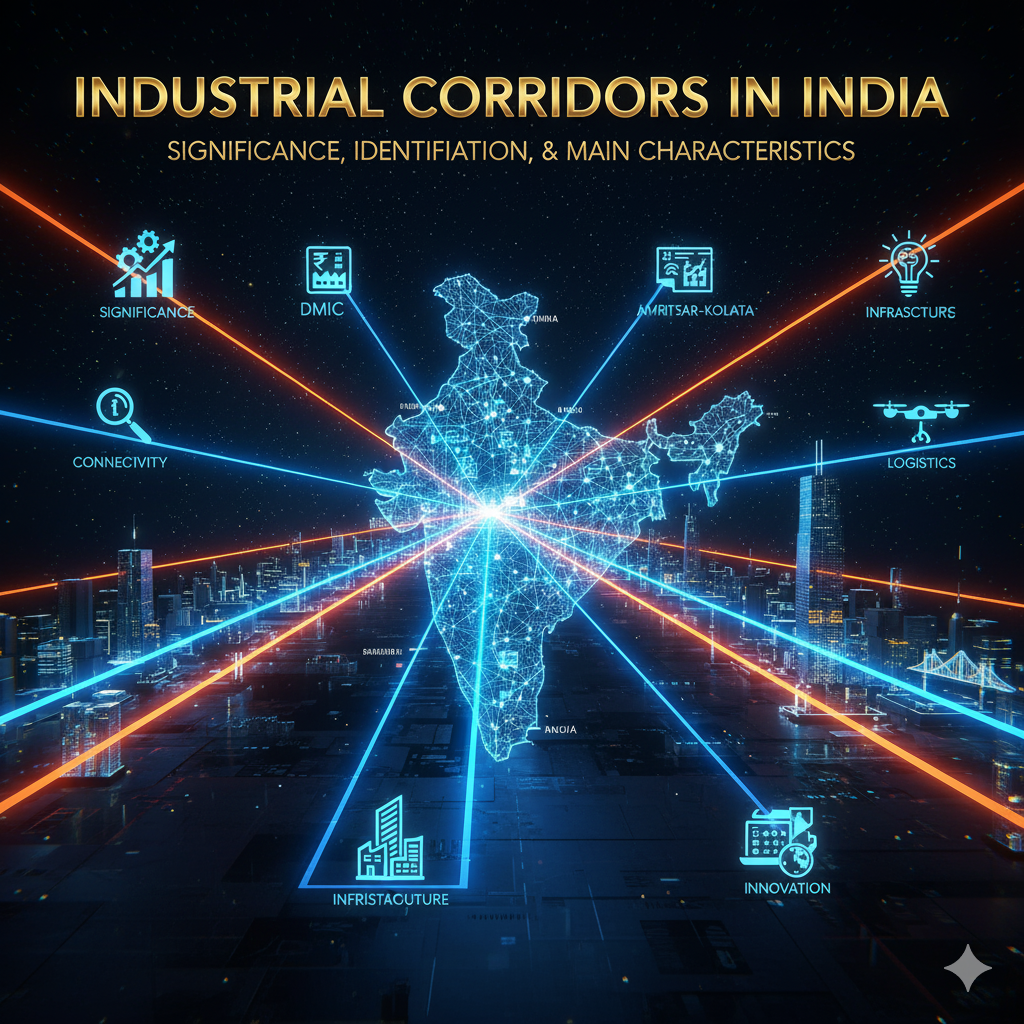Introduction
Industrial corridors are strategically planned zones aimed at promoting industrial development, improving connectivity, and fostering economic growth in a region. They are usually long stretches of infrastructure development that include transportation networks, industrial clusters, logistics hubs, and urban settlements.
India, as one of the fastest-growing economies in the world, has recognized the need to develop modern industrial corridors to enhance manufacturing capacity, attract investment, generate employment, and reduce regional disparities. These corridors are closely linked with the government’s “Make in India” initiative and the vision of transforming India into a global manufacturing hub.
Industrial corridors combine urbanization, industrialization, and infrastructure development to create high-productivity economic regions.
1. Significance of Industrial Corridors in India
Industrial corridors are crucial for accelerated economic development and have multiple socio-economic and strategic benefits:
1.1 Economic Significance
- Boosting Manufacturing Sector:
- Industrial corridors facilitate the growth of industries, reducing dependency on imports and promoting domestic manufacturing.
- Example: Automobile, electronics, textile, and defense manufacturing clusters along corridors.
- Industrial corridors facilitate the growth of industries, reducing dependency on imports and promoting domestic manufacturing.
- Attracting Investment:
- Well-planned corridors with connectivity, logistics, and urban infrastructure attract domestic and foreign direct investment (FDI).
- Well-planned corridors with connectivity, logistics, and urban infrastructure attract domestic and foreign direct investment (FDI).
- Employment Generation:
- Large-scale industrial and infrastructure projects generate millions of direct and indirect jobs, benefiting both skilled and unskilled labor.
- Large-scale industrial and infrastructure projects generate millions of direct and indirect jobs, benefiting both skilled and unskilled labor.
- Promotion of MSMEs:
- Industrial corridors provide supply chain and logistics support to micro, small, and medium enterprises, integrating them into larger industrial ecosystems.
- Industrial corridors provide supply chain and logistics support to micro, small, and medium enterprises, integrating them into larger industrial ecosystems.
- Balanced Regional Development:
- Reduces economic disparity between states and regions by creating growth centers beyond metropolitan areas.
1.2 Infrastructure and Connectivity Benefits
- Enhanced Transportation Networks:
- Highways, railways, ports, and airports are developed alongside corridors, reducing logistics costs.
- Highways, railways, ports, and airports are developed alongside corridors, reducing logistics costs.
- Logistics and Supply Chain Efficiency:
- Development of dedicated freight corridors, industrial parks, and logistics hubs ensures faster movement of goods.
- Development of dedicated freight corridors, industrial parks, and logistics hubs ensures faster movement of goods.
- Urban Planning Integration:
- Smart cities, housing, and urban amenities developed along corridors improve quality of life for workers.
- Smart cities, housing, and urban amenities developed along corridors improve quality of life for workers.
- Energy and Utility Infrastructure:
- Industrial corridors ensure reliable power, water supply, and digital connectivity, which are critical for modern industries.
1.3 Strategic and Environmental Significance
- Geopolitical and Trade Advantages:
- Industrial corridors along coastal areas and borders enhance trade, export competitiveness, and strategic security.
- Industrial corridors along coastal areas and borders enhance trade, export competitiveness, and strategic security.
- Sustainable Industrialization:
- Proper planning enables environmental safeguards, green belts, and efficient resource utilization, promoting sustainable development.
- Proper planning enables environmental safeguards, green belts, and efficient resource utilization, promoting sustainable development.
- Innovation and Skill Development:
- Industrial corridors become hubs for research, skill training, and innovation, enhancing the human capital of the region.
2. Identifying Industrial Corridors in India
India has initiated several key industrial corridors, often integrating Dedicated Freight Corridors (DFC), national highways, ports, and urban development. Some of the prominent corridors are:
2.1 Delhi-Mumbai Industrial Corridor (DMIC)
- Length: ~1,500 km
- States Covered: Delhi, Haryana, Uttar Pradesh, Rajasthan, Gujarat, Maharashtra
- Features:
- High-speed freight and logistics network
- Multi-modal transport connectivity
- Planned industrial townships and smart cities
- Focus on sectors like automotive, electronics, textiles, and defense
2.2 Chennai-Bengaluru Industrial Corridor (CBIC)
- Length: ~560 km
- States Covered: Tamil Nadu, Karnataka, Andhra Pradesh
- Features:
- Boosts manufacturing clusters for IT, electronics, and aerospace
- Multi-modal connectivity with ports, highways, and railways
- Integration with SEZs and industrial parks
2.3 Bengaluru-Mumbai Economic Corridor (BMEC)
- Purpose:
- Enhances trade between western and southern India
- Strengthens logistics efficiency and industrial linkages
2.4 Amritsar-Kolkata Industrial Corridor (AKIC)
- States Covered: Punjab, Haryana, Uttar Pradesh, Bihar, Jharkhand, West Bengal
- Focus:
- Agro-industries, manufacturing clusters, and urban infrastructure development
- Integrates Eastern and Northern India for balanced growth
2.5 Vizag-Chennai Industrial Corridor (VCIC)
- Purpose:
- Coastal corridor focusing on ports, logistics, and manufacturing hubs
- Promotes trade and industrialization along eastern coast
2.6 Additional and Emerging Corridors
- East Coast Economic Corridor (ECEC)
- Udhampur-Srinagar-Baramulla Industrial Corridor (under planning)
- Western Peripheral Corridor (planned for defense and manufacturing)
3. Main Characteristics of Industrial Corridors
Industrial corridors share several common features that distinguish them from regular industrial zones:
3.1 Spatial and Structural Characteristics
- Linear Development Pattern:
- Stretch over long distances connecting major cities, ports, and industrial clusters.
- Stretch over long distances connecting major cities, ports, and industrial clusters.
- Integration with Transport Networks:
- Corridors are aligned with national highways, freight corridors, ports, and railways to ensure connectivity.
- Corridors are aligned with national highways, freight corridors, ports, and railways to ensure connectivity.
- Industrial Cluster Formation:
- Specific sectors are concentrated in designated zones, enabling specialization and economies of scale.
- Specific sectors are concentrated in designated zones, enabling specialization and economies of scale.
- Planned Urban and Residential Areas:
- Smart cities, townships, and housing for workers are integrated within the corridor.
3.2 Economic and Functional Characteristics
- Multi-Modal Transport:
- Integration of road, rail, port, and air transport to reduce logistics costs.
- Integration of road, rail, port, and air transport to reduce logistics costs.
- Export-Oriented Industrial Zones:
- Many corridors have Special Economic Zones (SEZs) or industrial parks promoting exports.
- Many corridors have Special Economic Zones (SEZs) or industrial parks promoting exports.
- Technology-Driven Manufacturing:
- Emphasis on modern industries, IT-enabled services, and high-tech manufacturing.
- Emphasis on modern industries, IT-enabled services, and high-tech manufacturing.
- MSME Promotion:
- Supply chain linkages support small and medium enterprises, integrating them into the industrial ecosystem.
3.3 Institutional and Governance Features
- Public-Private Partnerships (PPP):
- Most industrial corridors are developed through PPP models, ensuring investment, efficiency, and sustainability.
- Most industrial corridors are developed through PPP models, ensuring investment, efficiency, and sustainability.
- Regulatory and Policy Support:
- Single-window clearances, investment incentives, and tax benefits simplify industrial establishment.
- Single-window clearances, investment incentives, and tax benefits simplify industrial establishment.
- Monitoring and Planning Authorities:
- Dedicated corridor development authorities oversee planning, implementation, and infrastructure management.
- Dedicated corridor development authorities oversee planning, implementation, and infrastructure management.
- Sustainability and Environmental Compliance:
- Green belts, renewable energy integration, and pollution control measures are incorporated.
3.4 Social and Human Resource Features
- Skill Development and Training Hubs:
- Industrial corridors often include technical and vocational training centers for workers.
- Industrial corridors often include technical and vocational training centers for workers.
- Community Amenities:
- Hospitals, schools, and recreational facilities improve quality of life for workers and residents.
- Hospitals, schools, and recreational facilities improve quality of life for workers and residents.
- Inclusive Development:
- Corridors aim to reduce regional inequalities, provide rural employment, and empower women through industrial employment.
4. Benefits of Industrial Corridors in India
- Accelerated Economic Growth:
- Industrial corridors act as engines of growth, enhancing GDP contribution from manufacturing and services.
- Industrial corridors act as engines of growth, enhancing GDP contribution from manufacturing and services.
- Enhanced Investment Climate:
- Well-planned corridors attract FDI, private investment, and technology transfer.
- Well-planned corridors attract FDI, private investment, and technology transfer.
- Regional Development:
- Promote industrialization in semi-urban and rural areas, reducing migration pressure on metros.
- Promote industrialization in semi-urban and rural areas, reducing migration pressure on metros.
- Job Creation:
- Direct, indirect, and allied employment opportunities in manufacturing, logistics, and services.
- Direct, indirect, and allied employment opportunities in manufacturing, logistics, and services.
- Improved Trade and Exports:
- Corridors connected to ports and airports facilitate efficient domestic and international trade.
- Corridors connected to ports and airports facilitate efficient domestic and international trade.
- Urbanization and Infrastructure Development:
- Smart cities, roads, housing, energy, and digital infrastructure development along corridors.
5. Challenges in Developing Industrial Corridors
- Land Acquisition Issues:
- Resistance from farmers and local communities can delay projects.
- Resistance from farmers and local communities can delay projects.
- Environmental Concerns:
- Deforestation, pollution, and ecological degradation risk sustainability.
- Deforestation, pollution, and ecological degradation risk sustainability.
- Financial Constraints:
- High capital investment required for multi-modal connectivity, urban planning, and industrial infrastructure.
- High capital investment required for multi-modal connectivity, urban planning, and industrial infrastructure.
- Inter-State Coordination:
- Multiple states’ involvement requires harmonized policies and regulations.
- Multiple states’ involvement requires harmonized policies and regulations.
- Skill Gaps:
- Insufficient trained workforce to meet the needs of modern manufacturing.
6. Strategies for Successful Industrial Corridor Development
- Integrated Planning:
- Combine industrial, urban, transport, and social infrastructure in corridor planning.
- Combine industrial, urban, transport, and social infrastructure in corridor planning.
- Public-Private Partnership Models:
- Encourage private investment, efficient project execution, and innovative financing.
- Encourage private investment, efficient project execution, and innovative financing.
- Skill Development Initiatives:
- Establish vocational and technical institutes to train workers in high-tech industries.
- Establish vocational and technical institutes to train workers in high-tech industries.
- Sustainable Practices:
- Adopt green energy, water conservation, and pollution control measures.
- Adopt green energy, water conservation, and pollution control measures.
- Technology Adoption:
- Implement smart logistics, IoT-based monitoring, and automation in manufacturing and supply chains.
- Implement smart logistics, IoT-based monitoring, and automation in manufacturing and supply chains.
- Regulatory Reforms:
- Simplify approvals, provide tax incentives, and ensure land acquisition is fair and transparent.
Conclusion
Industrial corridors are a strategic tool for India’s economic transformation. By connecting cities, ports, industrial clusters, and urban settlements, they promote manufacturing, trade, and employment, while reducing regional disparities. Corridors such as DMIC, CBIC, and AKIC demonstrate how integrated planning can boost industrial productivity, attract investment, and foster sustainable development.
The main characteristics of industrial corridors—linear development, multi-modal connectivity, industrial clusters, urban integration, policy support, and skill development—make them engines of economic growth. However, challenges like land acquisition, environmental concerns, and skill gaps must be addressed through policy support, PPP models, sustainable practices, and integrated planning.
By leveraging industrial corridors, India can achieve balanced regional development, enhanced global competitiveness, and long-term socio-economic prosperity, fulfilling the vision of a modern industrial nation.
Key Summary Points
Strategies: integrated planning, skill development, technology adoption, sustainable practices, and regulatory reforms.
Industrial corridors promote industrialization, urbanization, and connectivity.
Key corridors include Delhi-Mumbai, Chennai-Bengaluru, Amritsar-Kolkata, and Vizag-Chennai.
They enhance investment, manufacturing, employment, exports, and regional development.
Main characteristics: linear layout, industrial clusters, multi-modal transport, urban planning, PPP models, and sustainability.
Challenges include land acquisition, environmental concerns, financial and regulatory issues.




